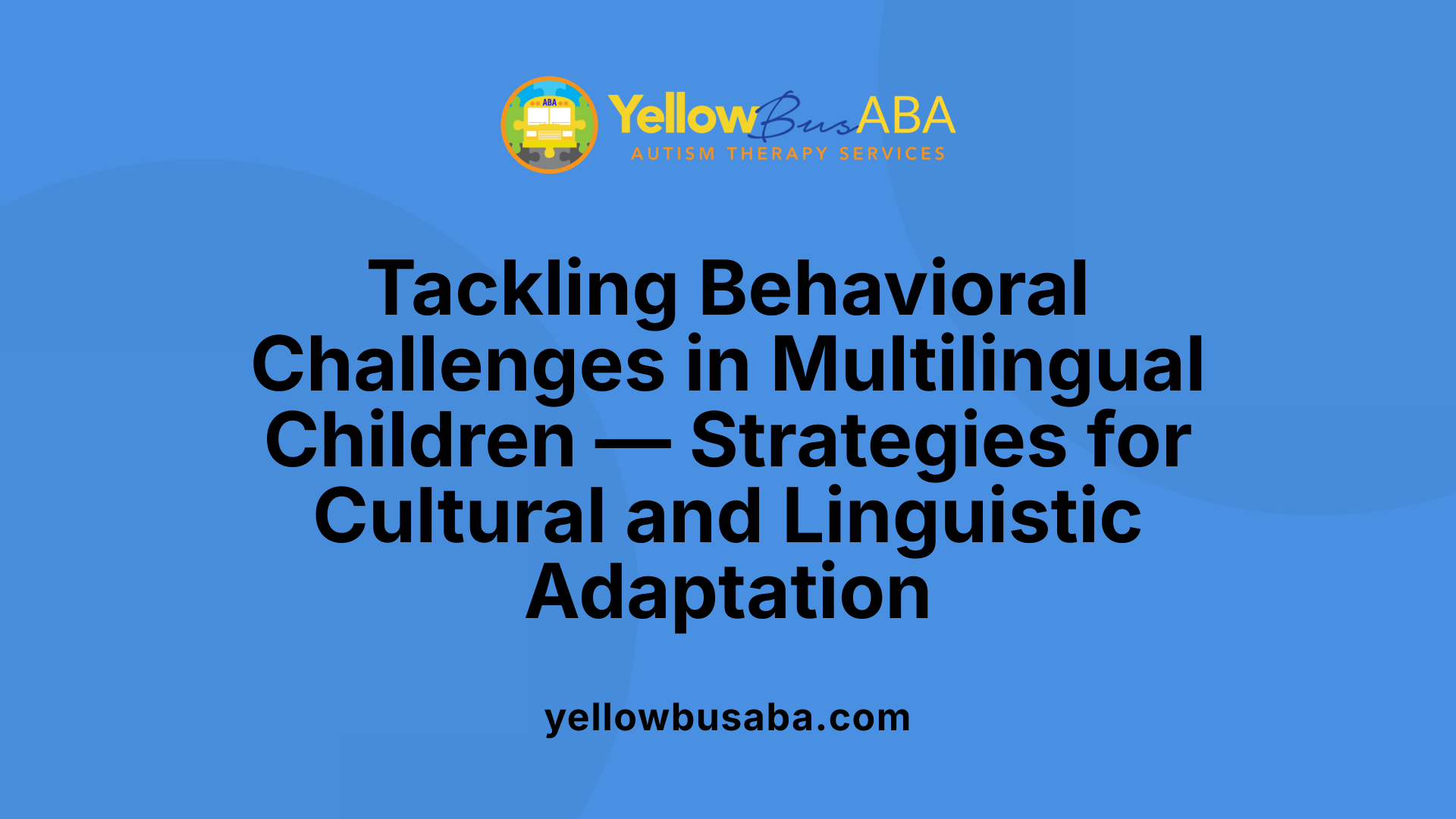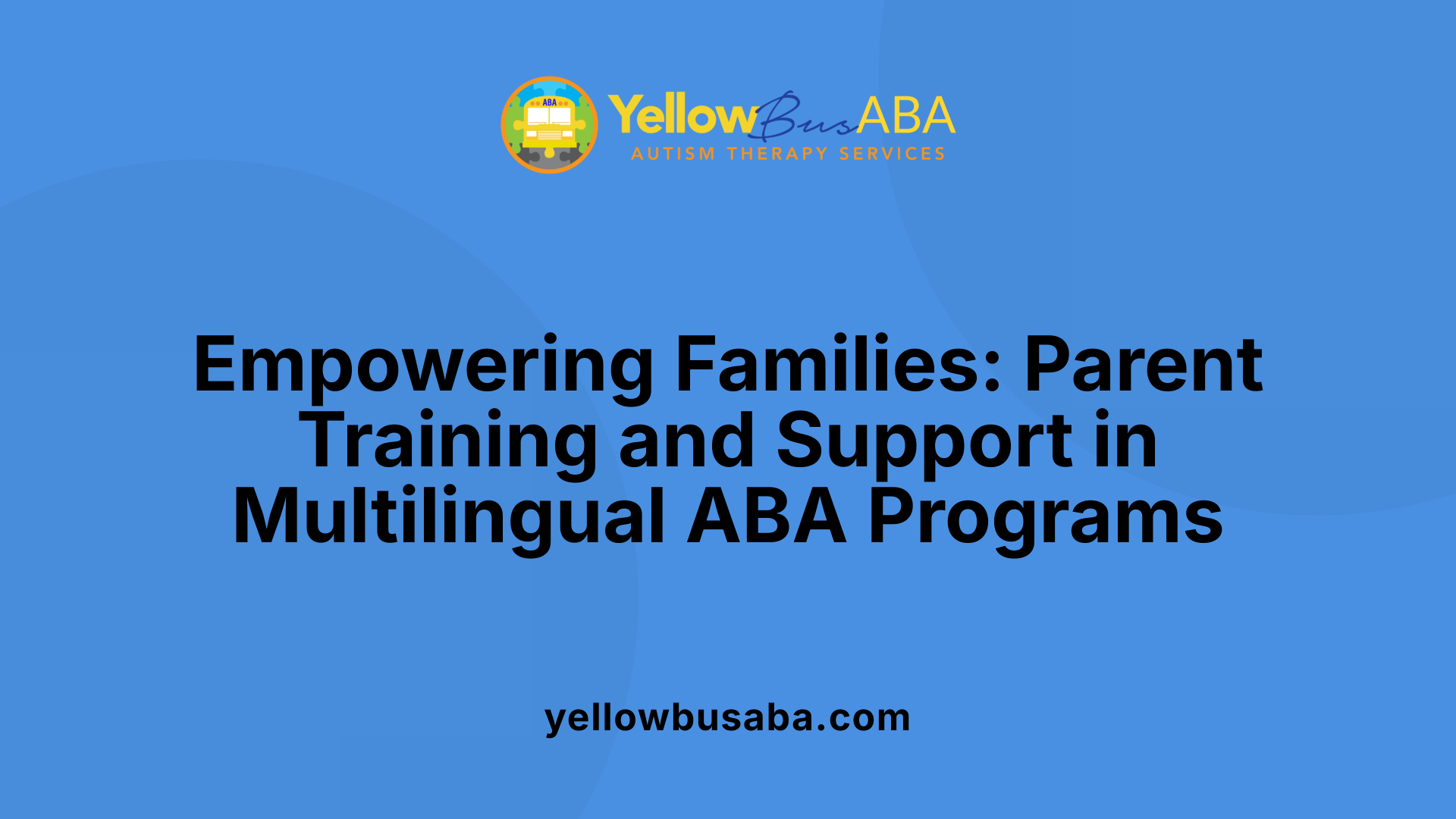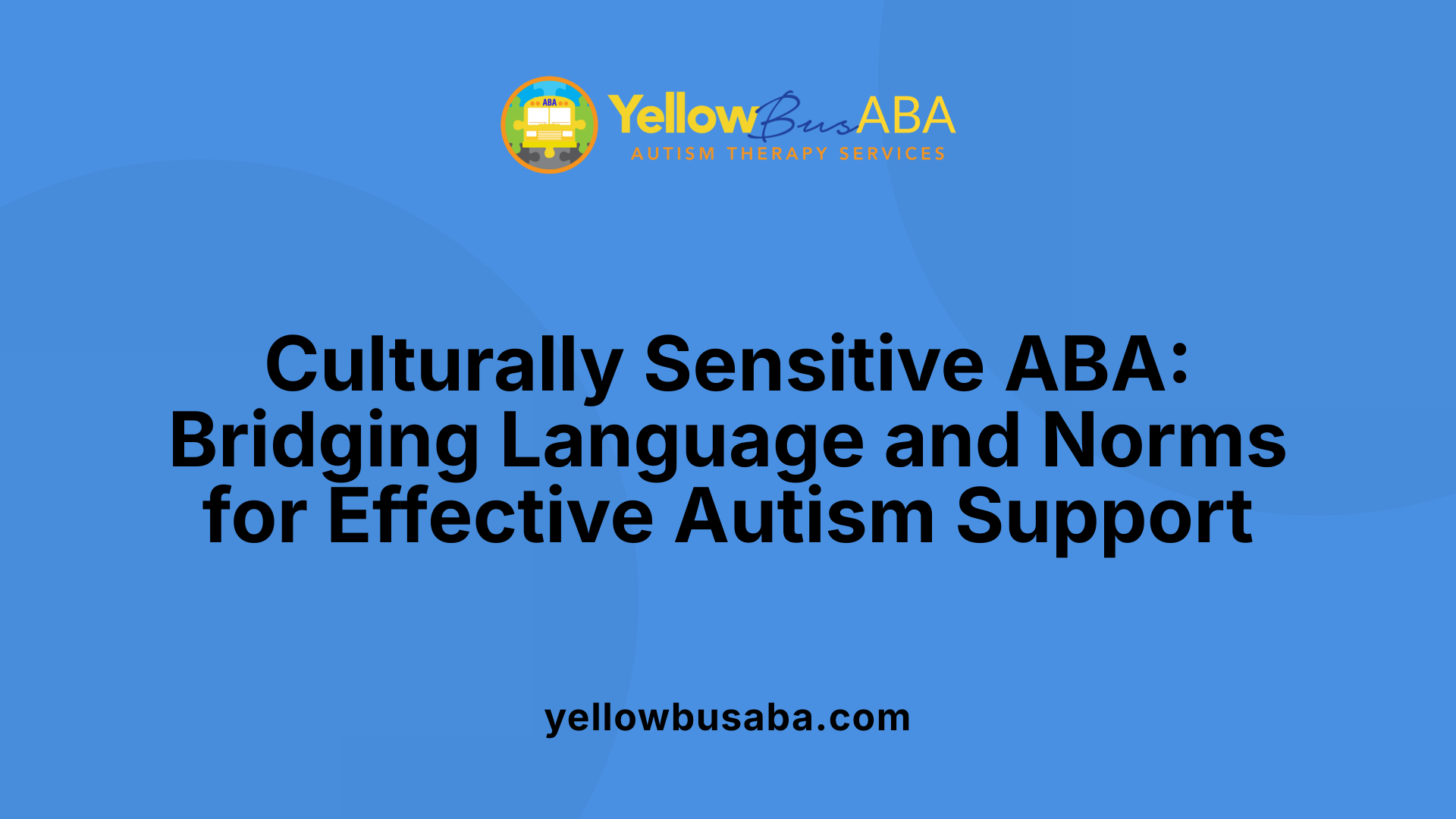Comprehensive ABA Therapy for Multilingual Families
October 29, 2025
Tailoring ABA Therapy to Meet the Unique Needs of Multilingual Families

Setting the Scene for Effective Autism Support in Multilingual Homes
Applied Behavior Analysis (ABA) therapy has long been recognized as a cornerstone in supporting children with autism spectrum disorder (ASD) by improving communication, social, and daily living skills. However, when it comes to multilingual families, delivering ABA therapy involves additional layers of cultural sensitivity, linguistic competence, and individualized planning. This article explores the multifaceted approach of comprehensive ABA therapy tailored specifically for multilingual families, highlighting strategies, challenges, and best practices that can improve outcomes and foster inclusivity.
Understanding ABA Therapy: A Science-Based Approach to Autism Support
What is applied behavior analysis (ABA) therapy, and how does it support individuals with autism?
Applied Behavior Analysis (ABA) therapy is a systematic, evidence-based practice that applies learning and behavioral science to improve skills and reduce challenging behaviors in individuals with autism. It involves understanding the functions of behaviors through the ABA "A-B-Cs" framework: Antecedents (what happens before a behavior), Behavior itself, and Consequences (what follows a behavior).
Scientific basis and principles
ABA therapy is grounded in behaviorism and the experimental analysis of behavior. Central techniques include positive reinforcement, where desirable behaviors are encouraged by rewarding them with meaningful reinforcers. This approach helps increase helpful behaviors while decreasing harmful or interfering behaviors. Treatment plans are individualized, developed by qualified Board Certified Behavior Analysts (BCBAs) who use comprehensive assessments to tailor goals and strategies.
Core goals and targeted behaviors
ABA programs target multiple developmental domains: communication, social skills, daily living and self-care, play, motor skills, and academics. These goals are broken down into small, measurable steps suited to each child’s needs. Intensive programs may range from 20 to 40 hours per week, focusing broadly or on specific skill deficits, depending on the type of ABA therapy.
Evidence supporting ABA effectiveness
ABA is recognized as an evidence-based practice endorsed by authorities such as the US Surgeon General and the American Psychological Association. Research spanning over six decades shows that intensive and sustained ABA interventions substantially improve intellectual functioning, language development, social skills, and reduce problematic behaviors. Insurance, including Medicaid, often covers medically necessary ABA services, affirming its clinical value.
Listing ABA's scientific foundation and proven outcomes highlights why it remains a cornerstone therapy offering individualized, structured support that enhances independence and quality of life for people with autism.
Who Delivers ABA Therapy? The Role of Professionals and Families
Who typically provides behavioral analysis and therapy services for autism?
Behavioral analysis and therapy services for autism are delivered primarily by trained professionals known as Board Certified Behavior Analysts (BCBAs). These specialists, along with therapists and clinicians well-versed in autism spectrum disorders, design and implement individualized ABA programs based on thorough assessments. They often work in clinical settings, specialized organizations, or home environments to provide tailored interventions that address communication, social skills, daily living skills, and behavior.
Why is family involvement and training crucial in ABA therapy?
Families play an essential role in successful ABA therapy outcomes. Parent training equips caregivers with knowledge and skills to consistently reinforce therapeutic strategies between sessions, fostering a supportive and consistent environment. This involvement encourages the generalization of acquired skills across different settings—home, school, and community—helping children apply learning in daily life. Moreover, parent participation in workshops, consultations, and support groups increases caregiver confidence, reduces stress, and promotes stronger parent-child relationships.
How does interdisciplinary collaboration enhance ABA treatment?
Effective ABA therapy benefits from collaboration among various professionals, including behavior analysts, speech therapists, occupational therapists, educators, and pediatricians. This team approach ensures comprehensive care that addresses varied developmental domains and health needs. Coordination between providers and families fosters aligned treatment goals and consistent strategies, thereby improving overall treatment efficacy. Such collaboration also ensures culturally sensitive practices and adapts interventions to family-specific linguistic and engagement capacities.
ABA therapy is not just delivered by credentialed professionals; empowered families and multidisciplinary teams are integral to creating successful and sustainable outcomes for children with autism.
Comprehensive ABA Therapy: Intensive and Holistic Intervention

What is Comprehensive ABA Therapy?
Comprehensive ABA therapy is an intensive, broad-based approach to Applied Behavior Analysis (ABA) designed to address multiple developmental areas in individuals, particularly children with autism spectrum disorder (ASD).
How Intensive is Comprehensive ABA Therapy?
This therapy typically involves 20 to 40 hours per week over the course of 1 to 3 years. Its high-intensity nature supports substantial developmental progress.
Which Domains Does It Cover?
Comprehensive ABA therapy targets various skills such as:
- Communication
- Social skills
- Daily living skills
- Play skills
It breaks treatment goals into small, teachable steps to maximize learning.
What Are Examples of Comprehensive ABA Techniques?
Two notable forms include:
Early Intensive Behavioral Intervention (EIBI): Focuses on young children under age 5. It builds foundational skills like attention, imitation, and early communication.
Natural Environment Teaching (NET): Implements ABA strategies in real-life settings, such as at home or in the community, embedding learning within everyday routines.
These methods emphasize applying behavior science systematically and consistently to enhance skill acquisition and reduce challenges across multiple areas of development.
Addressing Behavioral Challenges Through ABA in Multilingual Contexts

What kinds of behavioral challenges can ABA therapy help address in individuals with autism?
ABA therapy is effective in tackling various behavioral challenges common among individuals with autism. These include difficulties with communication and social interaction, repetitive behaviors, and sometimes self-injurious actions. By focusing on teaching functional, socially meaningful skills, ABA helps reduce problematic behaviors systematically. Techniques such as positive reinforcement and functional communication training are adapted to each individual's unique needs and developmental stages. Ultimately, ABA aims to enhance independence and social participation while improving daily living, attention, and academic skills.
How does ABA therapy address communication, social, and repetitive behaviors?
ABA uses a blend of evidence-based strategies to promote skill development and manage challenging behaviors. Communication skills are improved through targeted interventions like language modeling and prompting, while social skills training focuses on turn-taking, eye contact, and understanding social cues. Repetitive behaviors are addressed by identifying their triggers and teaching alternative, acceptable responses using the ABA A-B-C framework (Antecedent-Behavior-Consequence). Positive reinforcement encourages desirable behaviors by rewarding them immediately, fostering consistent progress.
What specific adaptations are needed for multilingual families?
Providing ABA in multilingual homes requires cultural sensitivity and linguistic competence. Programs must adapt language targets and intervention methods to the family's primary languages and cultural norms. This includes using materials in the family's languages, training caregivers to implement strategies across languages, and considering each child's bilingual development when setting goals. Practitioners should ensure clear communication and cultural respect, which help improve caregiver engagement and therapy effectiveness.
How are behavioral goals tailored to cultural and linguistic realities?
Behavioral goals in ABA are individualized to reflect the child’s cultural background and linguistic environment. This ensures that targeted skills are relevant and beneficial in the child’s daily life. For example, social skills training might incorporate culturally appropriate social norms, and communication goals might prioritize the dominant home language or any language critical for social participation. Such tailoring requires collaboration with families to understand their values and practical needs, leading to ABA interventions that are respectful, meaningful, and successful.
Evaluating and Monitoring ABA Effectiveness in Multilingual Families
How is the effectiveness of ABA therapy evaluated?
Evaluating ABA therapy success relies heavily on data-driven progress monitoring. Therapists collect detailed behavioral data that capture specific, measurable changes such as increases in functional communication, social interactions, and decreases in challenging behaviors. This data is gathered consistently during therapy sessions and daily routines.
Use of behavioral data to guide therapy
Behavioral data is often represented graphically to illustrate trends over time, making it easier for clinicians and families to see progress or areas needing attention. These visuals inform decisions about continuing, modifying, or intensifying certain interventions to best support the child's development.
Collaboration among therapists, caregivers, and families
Close collaboration between therapists, caregivers, and families is crucial, especially in multilingual and culturally diverse homes. Caregivers are trained to collect data and report observations across daily environments, ensuring continuity of measurement beyond clinical settings. This partnership also provides qualitative insights that complement quantitative data.
Adjusting programs for optimal outcomes
Based on ongoing progress reviews, behavior analysts adjust therapy goals and techniques to address emerging needs or new challenges. Tailoring programs to respect linguistic and cultural backgrounds enhances engagement and reinforces generalization of skills across settings.
Effective ABA evaluation is thus a continuous, collaborative process using objective data and open communication to ensure interventions are responsive and effective within diverse family contexts.
Parent Training and Support: Crucial Pillars in Multilingual ABA Therapy

What Is the Role of Parent Training and Involvement in ABA Therapy?
Parent training and involvement are essential components of successful ABA therapy, especially for children with autism. When parents actively participate, there is a noticeable improvement in communication, social skills, and behavior. Training empowers caregivers to consistently reinforce therapeutic strategies outside formal sessions, providing a seamless and supportive environment for the child’s development.
How Can Multilingual Caregivers Be Empowered Through ABA Techniques?
Empowering multilingual caregivers involves providing culturally and linguistically appropriate training tailored to their family's needs. This includes clear communication in their preferred language and practical demonstrations of ABA techniques, such as positive reinforcement and step-by-step teaching methods. Training also equips caregivers to understand and apply the ABA "A-B-Cs" framework—antecedents, behavior, and consequences—helping them manage behaviors effectively at home.
How Does Parent Training Support Generalization of Skills Across Settings?
Parents trained in ABA strategies play a vital role in helping children generalize learned skills from therapy sessions to everyday environments like home, school, and community. By integrating ABA principles during daily routines and natural activities, caregivers ensure that children apply skills consistently, boosting confidence and independence.
What Are the Benefits of Community Support and Stress Reduction for Families?
Parent support groups and activities foster a sense of community, enabling families to share experiences and resources. This social network enhances resilience, reduces parental stress and anxiety, and improves overall family functioning. Increased caregiver confidence from these programs strengthens positive parent-child relationships, contributing significantly to children's developmental progress.
Cultural Competency and Linguistic Sensitivity in ABA Therapy Delivery

Why is culturally appropriate ABA practice important?
Cultural appropriateness in ABA therapy ensures that interventions align with the family's values, norms, and beliefs. This relevance strengthens engagement and makes therapy more effective. Families from diverse backgrounds benefit when therapy respects their cultural context, improving children's learning and generalization of skills.
What challenges arise due to linguistic competence and family engagement?
Language barriers and differing cultural expectations can hinder communication between therapists and families. Families with limited English proficiency may struggle to grasp ABA concepts, limiting their ability to participate fully. Additionally, cultural norms may influence how behaviors are perceived and what treatment goals are prioritized.
What strategies help overcome cultural and linguistic barriers?
Practitioners can use several strategies:
- Employ culturally responsive teaching methods that respect family values.
- Provide therapy materials and training in the family's primary language.
- Build strong, trusting relationships to encourage open communication.
- Collaborate closely with caregivers to tailor goals that match cultural preferences.
- Utilize interpreters or bilingual support when needed.
What current knowledge gaps exist and recommendations for practitioners?
There is a notable lack of extensive empirical research on cultural competency in ABA therapy. Practitioners are encouraged to:
- Seek ongoing cultural competency training.
- Use evidence-based practices that incorporate cultural sensitivity.
- Engage in reflective practices to evaluate and adjust their cultural responsiveness.
- Advocate for more research to build a stronger evidence base for culturally sensitive ABA services.
Addressing these considerations helps create inclusive ABA programs that meet diverse family needs, promoting better outcomes for children with autism.
Moving Forward: Embracing Diversity in ABA Therapy
Comprehensive ABA therapy represents a powerful, evidence-based approach to supporting individuals with autism, yet its success is deeply tied to culturally and linguistically sensitive delivery—especially for multilingual families. Through collaborative partnerships between trained professionals and families, ongoing evaluation of therapeutic effectiveness, and a strong emphasis on parent training and cultural competency, ABA programs can be tailored to meet the unique needs of diverse communities. Embracing these considerations not only enhances skill development and behavioral outcomes for children with autism but also nurtures family resilience and inclusivity. As research progresses and more practitioners adopt culturally informed practices, the field moves closer to truly equitable care that respects each family’s language, culture, and values.
References
- Are There Different Types of ABA Therapy?
- Parent Training and Support in ABA Therapy
- Applied Behavior Analysis (ABA)
- Applied Behavior Analysis as Treatment for Autism ...
- Delivering Home-Supported Applied Behavior Analysis ... - UA
- Concerns About ABA-Based Intervention: An Evaluation ...
- Applied Behavior Analysis (ABA)
- The Controversy Around ABA






